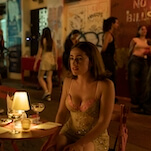Since 2007, TV Club has dissected television episode by episode. Beginning this September, The A.V. Club will also step back to take a wider view in our new TV Reviews section. With pre-air reviews of new shows, returning favorites, and noteworthy finales, TV Reviews doesn’t replace TV Club—as usual, some shows will get the weekly treatment—but it adds a look at a bigger picture.
The key influence on Getting On, HBO’s new comedy set in a geriatric ward in Long Beach, California, is The Office—the original U.K. Office, in all its despair and glory, with the boss who never got a victory and the many characters stuck at their workplace and in their lives. Getting On, closely translated from a BBC4 original of the same name, captures that spirit of soul-crushing despair, leavened by moments of deep humanity extraordinarily well. Naturally, HBO is burning it off over the holidays.
The series is not an easy watch. Of the three main characters, Laurie Metcalf’s head doctor is similar to the unthinking boss of The Office, but she’s also got a cruel streak that makes her harder to take, while Alex Borstein’s sweet-natured nurse is often shown to be incredibly incompetent at what she does—both in her professional and personal lives. Only Niecy Nash’s new nurse on the ward seems like a genuinely good person who’s also good at her job. She becomes almost immediately embroiled in a lengthy workplace dispute, forcing her to deal with union reps and human resources regarding a homophobic epithet tossed toward one of the few male nurses (Mel Rodriguez) on the ward.
All of that would be fine in a more typical workplace comedy. But this show is set in a workplace where the nurses and doctors are surrounded by people’s death in an underfunded ward that has become something of a dumping ground for other hospitals, creating the sense that the characters are trapped by unrelenting misery. Particularly in the early episodes, the show has trouble modulating the “sad” part of its ideal funny-sad mixture, with some half-hours trending too far toward the characters being awful to each other, while the howls of the dying surround them.
Watch Getting On long enough, though, and it reveals a streak of humane empathy for everyone trapped by either circumstance or choice in its intentionally claustrophobic setting. (The series never leaves the confines of the ward, and that makes the space feel particularly lived-in, which can be a problem for some six-episode orders.) Big Love creators Mark V. Olsen and Will Scheffer translated the series to the U.S., and while complaints of too many different plot threads in the same season can be made, it was never a series that lacked compassion. In bringing the original to HBO, Olsen and Scheffer have keyed in on that again, as characters begin to show facets that weren’t at previously at play.
It helps that they’ve landed a terrific guest cast to help out their central foursome (who are similarly very good, with Nash proving the standout). Harry Dean Stanton follows his former bosses over for a one-episode stint, while Molly Shannon also turns up as a patient’s daughter, struggling to deal with her mother’s condition, and Daniel Stern essays the role of a drunken husband who’s brought into the ward one night and forced to stay put, while his wife deals with something other than him.
It’s that late-night episode—the fifth and the last sent out by HBO to critics—in which Getting On finally pulls all of its pieces together and feels like something that deserves a better future than airing one of its episodes on the Sunday after Thanksgiving and its finale on the Sunday after Christmas when no one will be watching TV. Its quiet, darkened setting and limited cast give it the feeling of a particularly good and profound one-act play, and the series settles into itself a little bit, embracing the melancholy and strangeness of the ward. It simply tells moving and funny stories about the difficult task of helping people pass onto whatever’s next in relative peace and comfort.
In its own way, Getting On feels like the perfect companion for Treme, the series that will lead into five of its six episodes. Both shows are minimally plotted. Both shows are almost effortlessly diverse (Getting On in body type, as well as racial dynamics). Both shows are, ultimately, more about capturing the feeling that rises in these settings, be that a great city or a final way station between here and the hereafter. Getting On captures the drudgery of work and life in this ward, but it also catches glimpses of the beauty, and it’s in those moments that it feels like a series that deserves better than it’s going to get.
Created for American television by: Mark V. Olsen, Will Scheffer, based on the BBC4 series created by Jo Brand, Joanna Scanlan, and Vicki Pepperdine
Starring: Laurie Metcalf, Alex Borstein, Niecy Nash, Mel Rodriguez
Debuts: Sunday at 10 p.m. Eastern on HBO
Format: Half-hour single-camera comedy
Five episodes watched for review









































